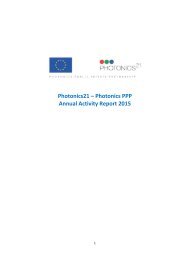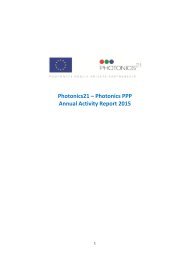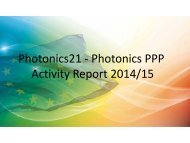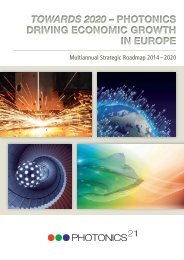of Photonics Technologies: the European Perspective The Leverage Effect
Create successful ePaper yourself
Turn your PDF publications into a flip-book with our unique Google optimized e-Paper software.
<strong>The</strong> <strong>Leverage</strong> <strong>Effect</strong> <strong>of</strong> <strong>Photonics</strong> <strong>Technologies</strong>: <strong>the</strong> <strong>European</strong> <strong>Perspective</strong><br />
computing and mobile communications (mobile phones), although <strong>the</strong><br />
boundaries between <strong>the</strong>se classifications are increasingly blurred (e.g.<br />
mobile TV).<br />
Research and development for displays and screens focus primarily on<br />
improvement in performance, new types <strong>of</strong> screens and innovations in<br />
manufacturing. Research aims to improve lifetime, brightness, colour<br />
coverage, energy efficiency, response speed and resolution. <strong>The</strong> research<br />
on new types <strong>of</strong> screens and displays looks at, for example, <strong>the</strong><br />
development <strong>of</strong> coloured electronic ink and flexible screens, as well as<br />
pico-projection, 3D and near eye displays. As well as performance, significant<br />
research attention is given to reducing costs in <strong>the</strong> manufacturing<br />
<strong>of</strong> screens and developing volume manufacturing processes. This is<br />
especially so for new and emerging display technologies which can only<br />
find market application with <strong>the</strong> development <strong>of</strong> cost effective high<br />
volume manufacturing processes. <strong>The</strong> <strong>European</strong> strengths are more<br />
oriented at <strong>the</strong> development <strong>of</strong> more radical new products (including<br />
design and human perception) and less at reducing cost for mass production.<br />
Also because <strong>of</strong> a historical development, <strong>the</strong> knowledge base<br />
on materials is strong in Europe.<br />
<strong>The</strong> production <strong>of</strong> base materials is also considered strong in Europe,<br />
as <strong>the</strong> market for some <strong>of</strong> <strong>the</strong>se input materials is dominated by <strong>European</strong><br />
companies [IPTS, 2009; evaluation workshop]. This is streng<strong>the</strong>ned<br />
mainly because <strong>of</strong> <strong>the</strong> strong connection to innovative <strong>European</strong> companies,<br />
who are in cooperation with research organisations, creating<br />
new display concepts.<br />
<strong>The</strong> actual production <strong>of</strong> displays (components) is dominated by Asian<br />
companies, especially from China and Korea. However, <strong>the</strong>se are mainly<br />
consumer oriented large volume products, where in <strong>the</strong> more niche<br />
oriented and high tech displays Europe still has a significant position.<br />
This includes <strong>the</strong> production <strong>of</strong> displays for non consumer markets like<br />
<strong>the</strong> automotive, healthcare and defence/security (pr<strong>of</strong>essional markets)<br />
where <strong>the</strong> UK and Germany are relatively highly represented. Also here,<br />
new and innovative concepts for (still) niche markets are <strong>of</strong> importance<br />
for <strong>European</strong> companies, (e.g. near eye displays).<br />
60 / 190<br />
<strong>The</strong> applications in enabled final markets are very diverse and as displays,<br />
content and data transmission continue to develop in parallel






